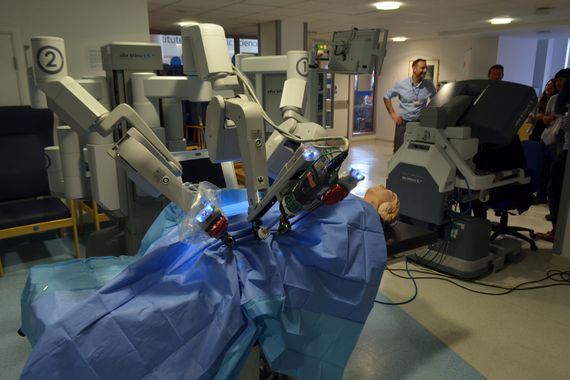It has been 31 years since the PUMA 560 robot, one of the original robotic surgical systems, was first used to place a needle for a brain biopsy in 1985. Since then robotic surgical systems have exploded in number. Shortly after PUMA 560 came the first FDA-approved system ROBODOC, designed to machine femurs in hip replacements. Since ROBODOC, this market has continued to expand. Intuitive Surgical Inc., the global leader in the robotic medical market, has placed its main product--the da Vinci Surgical System--in over 800 hospitals across America and Europe.
The term robotic is a bit of a misnomer, however. Technically speaking, these systems are not robots because the machine is not performing the operation on its own. It's actually computer-assisted surgery. Though human surgeons are not directly moving instruments with their hands, they are still seated at a console several feet from the system, operating the surgery with joysticks. Yet as these systems become better and better, will there become a point where doctors will be obsolete? Where these robotic surgical systems actually live up to their name of robot?
The benefits to these systems abound. A 2013 survey from the FDA found patients operated on by the da Vinci surgical system experienced less bleeding, fewer complications, and spent, on average, 24 less hours on recovery time. The miniaturized surgical instruments on the robotic arms allow for miniscule incisions, leaving less chance for infection and scarring. Magnified, high-definition cameras allow surgeons to zoom in until spidery veins look as thick as pens. And, possibly the greatest advantage, these machines don't tire, and they don't tremor. At the end of an all-day surgery, the metallic forceps will still be steady. With these obvious benefits, and the spike in research for this field, it would make sense to be working towards full autonomy. If humans can be completely eliminated from the equation, there is no room for error.
In fact, in 2003 a performance study comparing manual laparoscopic surgery to assisted surgery with the da Vinci system was done. Six last-year medical students were selected to perform a surgery twice--once manually and once with assistance from the da Vinci system. Time for completion and median number of errors were noted. It was found that the students not only finished significantly quicker when assisted by da Vinci, but also performed far fewer errors.
Though the benefits are obvious, the question still remains: should these robotic surgical systems become fully autonomous? As more research institutions funnel funds into this very solution, the question becomes not one of if, but one of when. One of the current only drawbacks for these systems is the loss of haptic feedback. Because the surgeons are no longer in direct contact with the surgery, they lose that sense of touch that allows them to apply the right amount of pressure to slicing. Again, though, this problem will be remedied by time. Haptic feedback systems are already in development. Controllers that output pressure to the user alerts them to exactly how deep a tissue or muscle is.
Despite the drawbacks to these systems that will be solved by time and research, the blocks to becoming fully autonomous go beyond the technical. If these machines do take over the operating room, what will that mean for surgeons and nurses? Will the medical field suddenly become occupations parents keep their kids away from, rather than one they endorse? Or will they remain the educated, highly-paid part of society they've always been, except sitting behind machines, monitoring surgery progress, rather than plunging instruments into hearts.
If this day ever dawns, it will be far into the future. Forget full autonomy--we are still not close to having robotic systems in all hospitals and medical centers. That is one checkbox we should fill before reaching for autonomy in the operating room.

